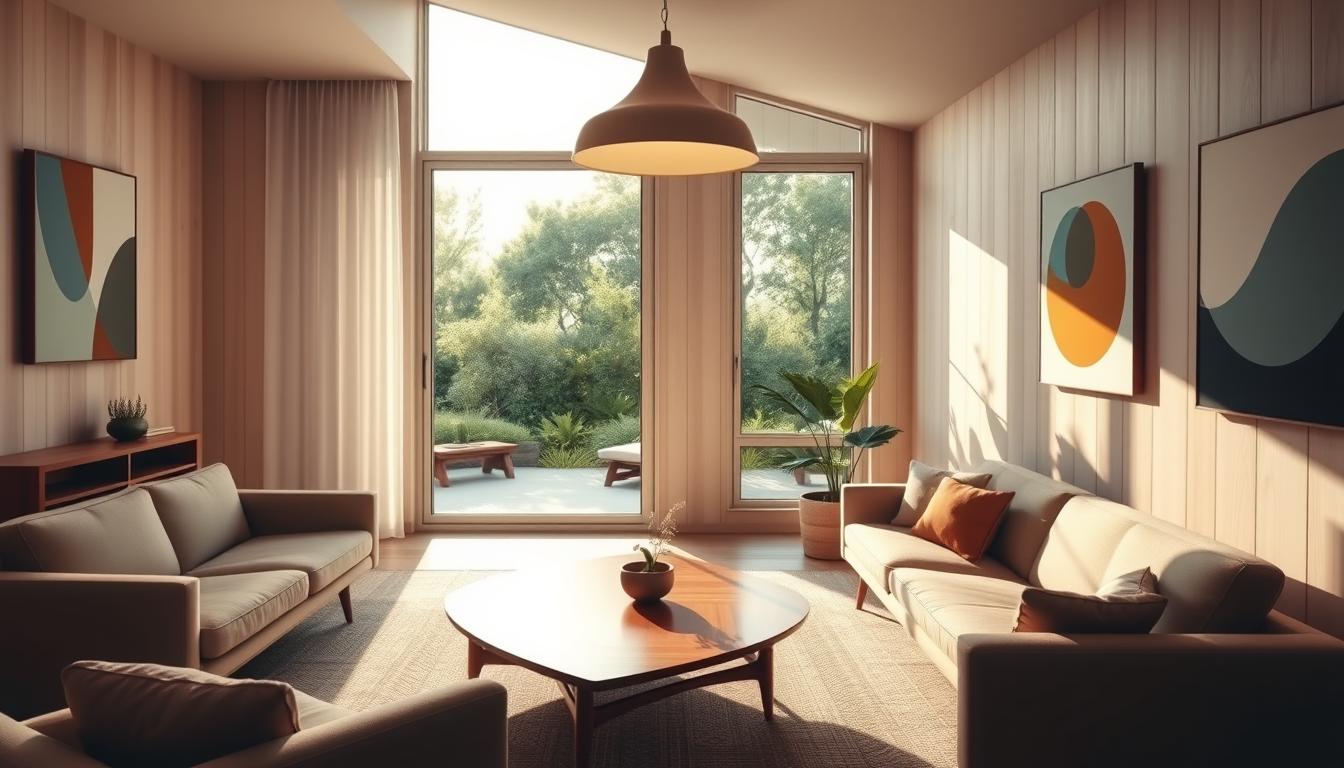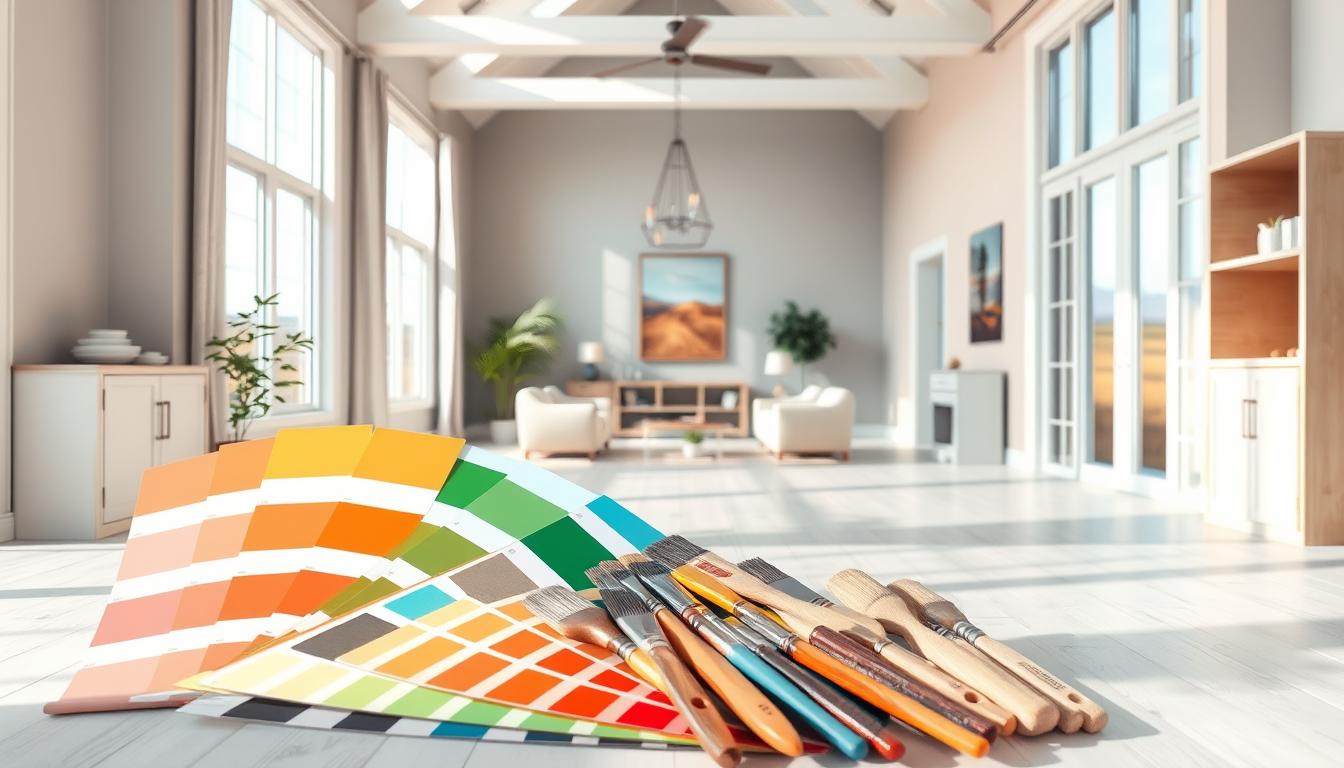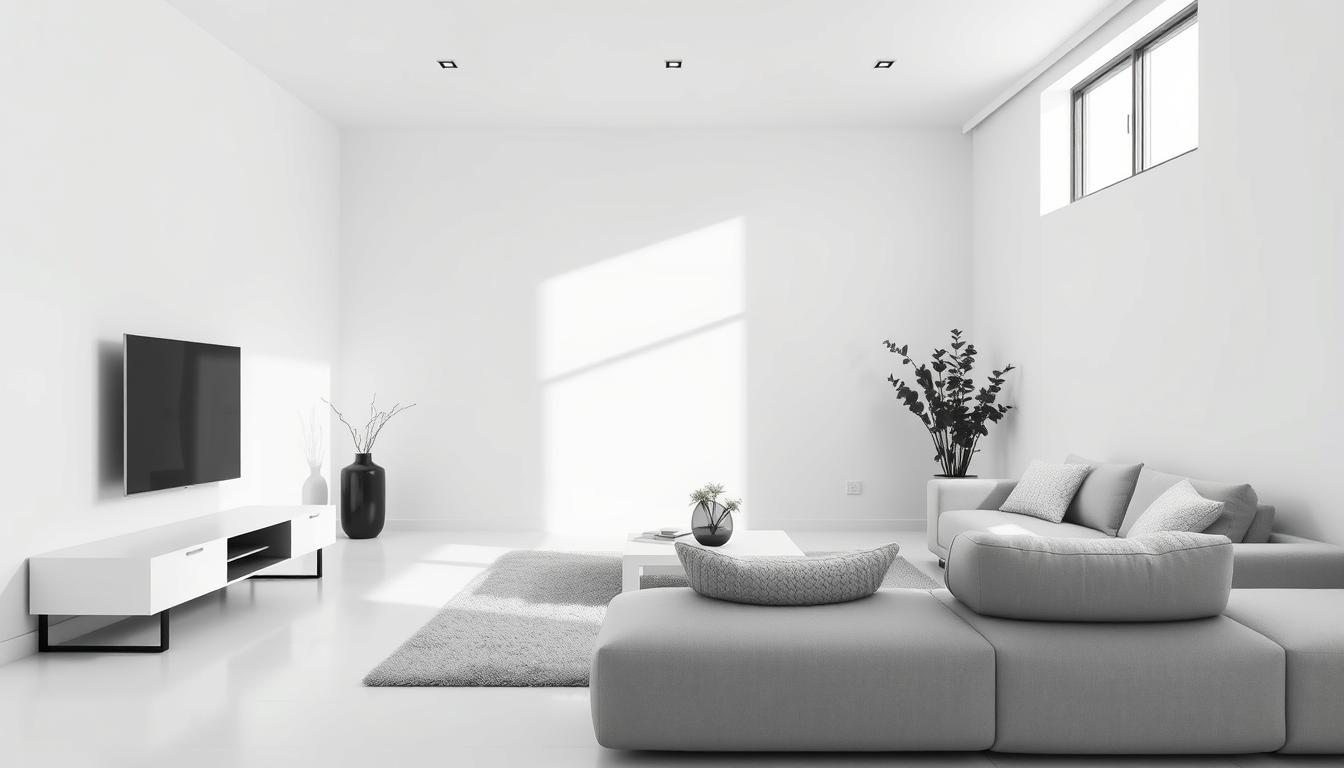The 1950s was a big change for home decor. It saw the rise of mid-century modern design. This style is known for clean lines, organic shapes, and mixing function with style.
This era’s look still shapes today’s retro home decor. The 1950s also saw a big move to suburban living. Homes became more spacious and comfy. This change affected how people decorated their homes.
To bring back the 1950s home interior, we need to capture its essence with a modern twist. We’ll look at the best ways to add vintage charm to your space. We’ll focus on the design elements that made the 1950s special.
Key Takeaways
- Understand the core elements of mid-century modern design.
- Learn how to incorporate retro color palettes into your decor.
- Discover the iconic furniture styles of the 1950s.
- Find out how to blend nostalgic elements with modern sensibilities.
- Explore ways to add vintage charm to your contemporary space.
Understanding the Essence of 1950s Home Design
The 1950s was a time of big change in home design. It brought new materials and bold colors. This era mixed post-war hope, modern ideas, and a hint of old times.
Key Characteristics of 1950s Interiors
The 1950s interiors were known for bold colors, geometric shapes, and new materials. Retro furniture styles had clean lines, organic shapes, and focused on being useful.
Design experts say, “The 1950s moved towards modern living. Homes became more open and connected to the outdoors.” This change showed in design, focusing on both looks and comfort.
Popular Color Palettes of the Era
The 1950s were full of bright and varied colors. 1950s color schemes included soft pastels, bold primary colors, and earthy tones. These colors were mixed to make spaces welcoming and unique.
- Pastel shades for a soft, calming effect
- Bold primary colors to add energy and vibrancy
- Earthy tones to bring warmth and coziness
Iconic Furniture Styles
Furniture from the 1950s was made with both looks and use in mind. Iconic pieces, like those from the mid-century modern style, had sleek designs and focused on comfort. These styles still influence today’s furniture.
By knowing these elements, we can add 1950s home design to our homes. It brings a mix of old charm and new usefulness.
Essential Elements of 1950s Home Decor
To make a 1950s home feel real, you need to add the era’s key design pieces. These include bold patterns and vintage appliances. The 1950s mixed old charm with new looks, showing the hope of the post-war time.
Bold Patterns and Textures
The 1950s were known for bold patterns and textures. Think geometric wallpaper and textured furniture. To bring this into your home, use vintage home accessories like throw pillows or blankets.
When picking patterns and textures, mix different styles. Aim for a look that’s both nostalgic and modern. For instance, a vintage rug with a modern sofa can be a cool contrast.
The Role of Kitchen Design
The kitchen was key in 1950s homes. It had bright colors, sleek surfaces, and nostalgic home decor. To get this look, add vintage or vintage-style appliances and fixtures to your kitchen.
A well-done kitchen can be the star of a 1950s home. Add vintage-style lights, retro appliances, or classic gadgets for a nostalgic vibe.
Vintage Appliances to Include
Vintage appliances are vital for a real 1950s home. They add to the nostalgic feel and are great conversation starters. When renovating a mid-century home, use vintage or vintage-style appliances to keep the charm.
Some cool vintage appliances to include are retro toasters, vintage mixers, and classic can openers. Display them on countertops or in vintage cabinets for a nostalgic feel.
Incorporating Mid-Century Modern Furniture
Mid-century modern furniture is known for its clean lines and organic shapes. It’s a key part of 1950s design that can make any room look better. This style is simple yet functional, making it perfect for today’s homes.
Signature Pieces for Your Living Room
When adding mid-century modern furniture to your living room, focus on key pieces. These include:
- Iconic Sofas: Look for sofas with sleek, low-profile designs and tufted upholstery.
- Eames Lounge Chairs: These chairs are quintessential mid-century modern pieces, known for their molded plywood and leather upholstery.
- Coffee Tables: Opt for coffee tables with simple, geometric shapes and tapered legs.
Mixing and Matching Styles
Mid-century modern furniture is versatile. You can mix different pieces to create a unique look. For example, pairing a vintage sofa with a modern coffee table adds interest. Here are tips for mixing styles:
- Start with a Neutral Base: Begin with a neutral-colored sofa or sectional to anchor the room.
- Add Statement Pieces: Incorporate bold, eye-catching pieces like a brightly colored armchair or a unique lighting fixture.
- Balance with Textiles: Use throw pillows, blankets, and rugs to add texture and warmth to the space.
Where to Find Authentic Pieces
Finding authentic mid-century modern furniture is a fun adventure. Here are places to look:
- Thrift Stores and Vintage Shops: You can often find hidden gems at thrift stores and vintage shops.
- Online Marketplaces: Websites like eBay and Craigslist can be great resources, but be sure to exercise caution when purchasing online.
- Estate Sales and Auctions: Estate sales and auctions can be a great way to find authentic mid-century modern pieces.
Color Schemes to Embrace
To bring back the charm of a 1950s home, you need to use the era’s color schemes. The 1950s were known for bold and inviting colors in home decor.
The 1950s mixed pastel hues with bright colors, creating a unique look. Let’s look at some classic color combinations that can make your home feel authentic.
Classic Combinations for Authenticity
Some iconic 1950s color schemes include:
- Pastel Paradise: Soft pastels like pale pink, baby blue, and mint green were popular. They created a calm atmosphere.
- Bold and Bright: Colors like red, turquoise, and yellow were used to add energy and make a statement.
- Neutral Backdrop: Beige, gray, and taupe were used as a neutral base to balance bold colors.
Accent Colors That Pop
Accent colors were key in 1950s decor, adding personality and color to rooms. Some favorite accent colors were:
- Turquoise: A signature color, turquoise was used in kitchen accessories and decorative items.
- Coral: This warm color was used in living rooms and dining areas to create a cozy feel.
- Yellow: Bright and cheerful, yellow was popular in kitchens and bathrooms.
When using accent colors, finding the right balance is crucial. Too much of a bold color can overwhelm a space. But a well-placed accent can make a room stand out.
Experimenting with Wall Treatments
1950s wall treatments were more than just paint. They added texture and pattern to rooms. Some popular options included:
- Wallpaper: Bold, geometric patterns were trendy, adding interest to walls.
- Paint Techniques: Techniques like ombre and sponging created unique effects.
- Wainscoting: Decorative paneling on lower walls added elegance.
By using these classic color schemes, accent colors, and wall treatments, you can make a home that feels like the 1950s. Whether you’re restoring a vintage home or adding nostalgic touches to a modern space, these tips will help you achieve a charming 1950s-inspired look.
The Importance of Lighting in 1950s Homes
Lighting in 1950s homes was more than just a need—it was a statement. Lighting fixtures were both useful and decorative. They showed off the homeowner’s style and the era’s design trends.
Iconic Lighting Fixtures
The 1950s brought iconic lighting that’s still loved today. Sputnik chandeliers, globe pendant lights, and sculptural table lamps were favorites. They were made from brass, copper, and glass, adding elegance to any room.
1950s lighting was known for bold shapes and new materials. Designers pushed boundaries, creating lights that were both beautiful and practical.
Layering Light for Ambiance
Layering light was key in 1950s home design. Mixing different lights made rooms warm and welcoming. This mix included overhead lights, table lamps, and floor lamps, each with its own role.
To get this layered look, use ambient, task, and accent lighting. Ambient lights provide overall light, task lights focus on specific areas, and accent lights highlight special features or art.
Modern Alternatives to Vintage Fixtures
Vintage lighting adds charm, but modern alternatives offer tech and energy savings. Many modern designs take inspiration from the 1950s, blending retro style with today’s needs.
For a modern take, look for mid-century modern inspired lights. These pieces bring the 1950s vibe to your home, combining style with function.
Revamping Floors with 1950s Flair
Floors are key in setting your home’s look. 1950s-inspired flooring is a great pick. This era had unique styles, using classic materials and designs.
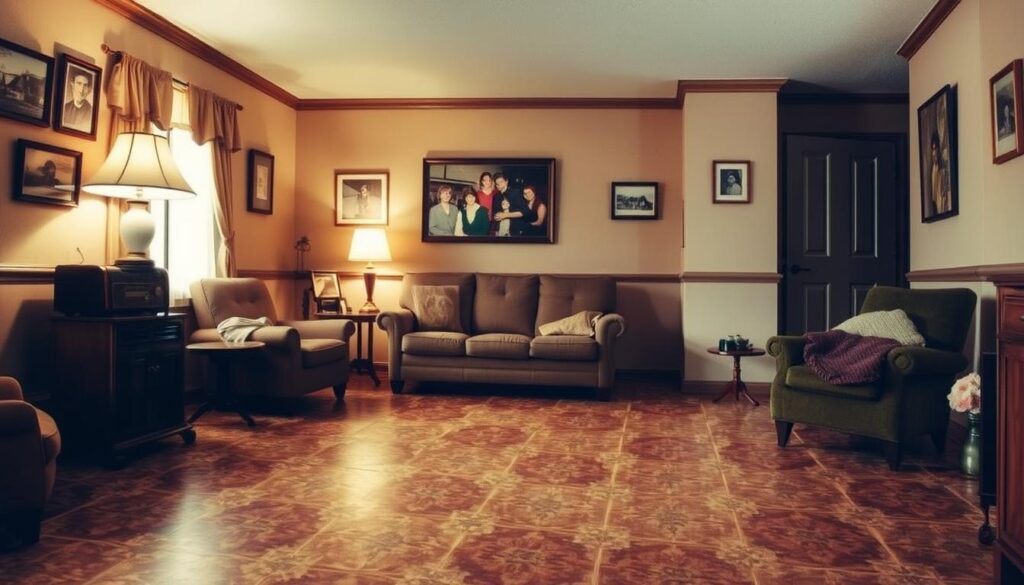
Classic Flooring Options
In the 1950s, homes often had hardwood, linoleum, and terrazzo floors. Hardwood, like oak, was durable and warm. Linoleum was popular for its natural materials and easy care.
Terrazzo, with marble or granite chips in cement, was also loved for its look and strength. These options are perfect for adding 1950s charm to your floors.
Incorporating Area Rugs
Area rugs were big in 1950s homes. They added warmth, texture, and color. Choose rugs with geometric patterns, floral motifs, and bold colors for a true 1950s vibe.
Maintenance Tips for Vintage Floors
Keeping vintage floors in good shape is important. Clean them regularly with the right products and avoid harsh chemicals. Apply protective coatings to keep them looking great.
For hardwood, refinishing it now and then can make it shine like new. Linoleum and terrazzo need special cleaners to stay beautiful. With these tips, you can make your floors look fabulous with 1950s flair.
Wall Art and Decorative Touches
Wall art and decorative touches were key in 1950s home decor. They showed the era’s cultural and artistic trends. The 1950s were a time of creativity, with new art forms and styles shaping home decor.
Popular Art Styles from the 1950s
The 1950s brought forth various art styles that became key in home decor. Some top styles include:
- Abstract Expressionism: Known for bold, abstract forms, this style added a dynamic feel to rooms.
- Pop Art: Focusing on popular culture and consumer products, Pop Art brought a playful, modern feel to homes.
- Retro Prints: Vintage prints, often with geometric patterns or nostalgic themes, were also in vogue.
These styles not only showed the artistic trends of the time but also made 1950s homes unique.
How to Choose Art that Fits
Choosing art for your 1950s-inspired home means looking at the style and era’s elements. Here are some tips:
- Find pieces that reflect the era’s popular art styles, like Abstract Expressionism or Pop Art.
- Think about your home’s color palette and pick art that matches it.
- Go for vintage or vintage-inspired prints to add authenticity.
Creating a Gallery Wall
A gallery wall is a fantastic way to show your personality and style while honoring 1950s decor. To make a gallery wall:
- Begin by picking a mix of frame styles and sizes that match the era.
- Arrange your frames on the floor before hanging them to see the layout.
- Balance the compositions by mixing different shapes and sizes.
By following these steps, you can make a unique and eye-catching gallery wall that boosts your 1950s-inspired home.
Bringing in the Outdoors: Garden and Patio
In the 1950s, outdoor living became a big part of modern life. Gardens and patios were seen as extensions of our homes. They were designed to be both beautiful and functional.
1950s Landscaping Trends
The 1950s brought new landscaping trends. They focused on simplicity and blending with nature. Some key trends included:
- Using native plants and flowers to create a seamless transition between the garden and the surrounding landscape.
- Incorporating geometric patterns and clean lines in garden design, reflecting the mid-century modern aesthetic.
- Creating defined areas within the garden for different activities, such as dining or lounging.
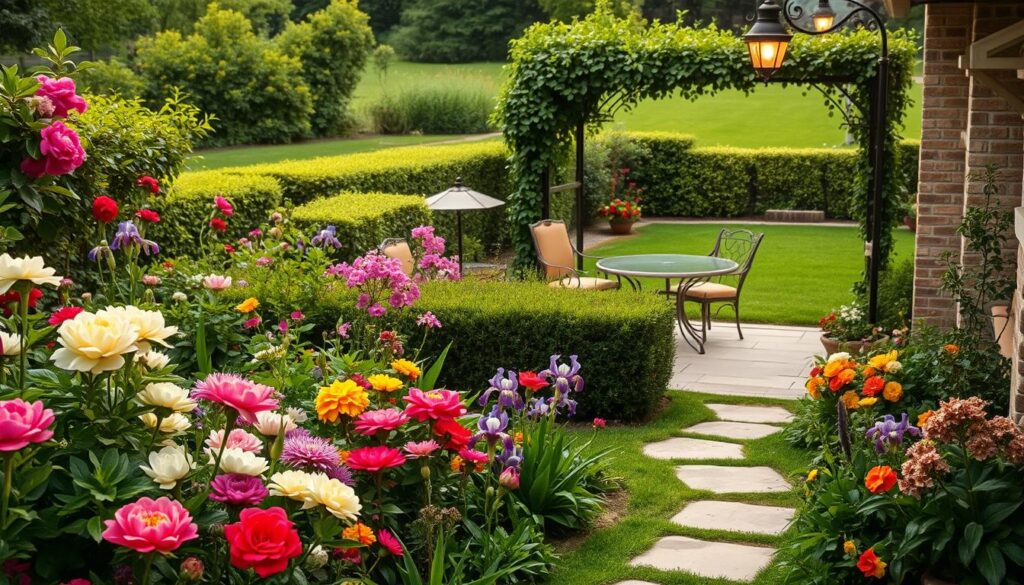
These trends made outdoor spaces more beautiful and functional. They were more inviting than ever before.
Retro Outdoor Furniture Options
Retro outdoor furniture from the 1950s is known for its durability and style. Some iconic pieces include:
| Furniture Piece | Description |
|---|---|
| Wicker Furniture | Known for its durability and natural look, wicker furniture was a staple in 1950s outdoor decor. |
| Metal Frame Chairs | Often paired with vinyl or fabric cushions, these chairs were both stylish and comfortable. |
| Outdoor Sofas | Designed to be both functional and stylish, outdoor sofas became a popular choice for patios and gardens. |
These retro furniture options can be mixed and matched. They help create a unique and inviting outdoor space.
Creating an Inviting Atmosphere
To make your garden or patio inviting, consider these tips:
- Use outdoor lighting to highlight key features and create ambiance.
- Incorporate comfortable textiles such as throw pillows and blankets to add warmth and coziness.
- Utilize plants and flowers to add color and texture to your outdoor space.
By adding these elements, you can make your outdoor space beautiful and welcoming. It will be a place where you and your guests can relax and enjoy.
Accessorizing with Vintage Finds
To truly capture the essence of 1950s home decor, incorporating vintage accessories is key. Vintage home accessories can add a layer of authenticity and nostalgic charm to your home.
Fun Finds at Thrift Stores
Thrift stores are treasure troves for unique vintage items. When searching for vintage home accessories, keep an eye out for items like vintage vases, retro posters, and antique decorative pieces. These items can be repurposed to fit your 1950s decor theme.
Some popular thrift store finds include:
- Vintage kitchen gadgets
- Retro-themed dinnerware
- Antique lamps and lighting fixtures
Where to Source Antique Accessories
In addition to thrift stores, there are several other places where you can find antique accessories to enhance your 1950s home decor. Antique stores, estate sales, and online marketplaces are excellent sources for vintage items.
When sourcing antique accessories, consider the following:
| Source | Pros | Cons |
|---|---|---|
| Antique Stores | Curated selection, often with provenance | Can be expensive |
| Estate Sales | Often contains original items from the era | Can be hit or miss, requires early arrival |
| Online Marketplaces | Wide selection, convenient | Quality can vary, beware of reproductions |
What to Avoid When Shopping
When shopping for vintage accessories, it’s essential to avoid reproductions or items that don’t fit your home’s aesthetic. Be cautious of items that are overly restored or altered, as they may lose their vintage charm.
Tips for avoiding common pitfalls:
- Inspect items carefully for signs of aging or wear.
- Research the item to understand its original context and value.
- Consider the item’s condition and whether it fits your decor.
By being mindful of these tips and sources, you can effectively accessorize your 1950s-inspired home with vintage finds that add to its nostalgic charm and authenticity.
Creating a Cohesive Look
A cohesive 1950s home interior design is more than just vintage items. It’s about mixing the era’s charm with today’s comforts.
Think about the style and atmosphere you want. Consider colors, textures, and furniture from the 1950s. Then, blend these with today’s elements.
Balancing Modern and Vintage Elements
Blending modern needs with vintage flair is key. Start with essential vintage pieces like a vintage sofa or retro-style fridge.
Next, add modern items that match these vintage pieces. For example, pair a vintage armchair with a modern coffee table. Add contemporary lighting to enhance the look.
Tips for Balancing:
- Mix vintage furniture with modern decor for a unique look.
- Use vintage items as statement pieces and balance with modern elements.
- Blend modern technology with vintage aesthetic.
How to Avoid Overdoing It
It’s easy to get lost in 1950s decor. But too much can make your space feel like a museum. Limit vintage pieces in each room and keep a clear flow.
Create a focal point in each room, like a vintage chandelier. Balance it with more subtle elements.
| Common Mistakes | How to Avoid Them |
|---|---|
| Overcrowding with vintage items | Select a few key vintage pieces and balance with modern elements. |
| Ignoring modern comforts | Add modern conveniences for style and function. |
Importance of Personal Touches
Authenticity is key, but personal touches make a house a home. Add family photos, heirlooms, or collections to your decor.
Personalizing your space makes it inviting and truly yours.
Final Touches for Authenticity
To finish your 1950s-inspired home, focus on the details. These details bring the era to life. By adding retro home decor, you’ll honor the past and show your style.
Completing the Look
To get a true 1950s look, add vintage accessories and decor. These items will make your mid-century home renovation complete. Look for vintage appliances and retro-patterned textiles to add nostalgia.
Maintaining Vintage Elements
When using vintage items, keep their charm alive. Check and restore them often to keep them in great shape. This care will keep your 1950s home authentic.
Embracing Your Unique Style
While inspired by 1950s design, add your own twist. Mix modern with vintage to create a unique space. This blend will make your home both nostalgic and modern.

